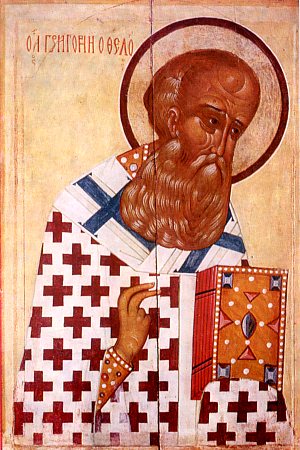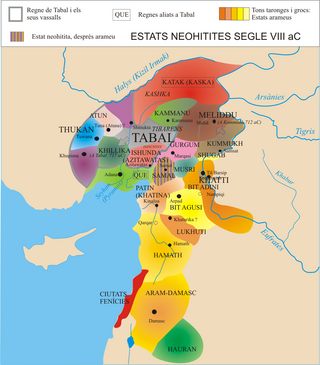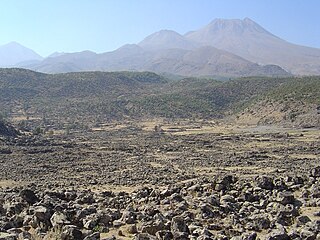Related Research Articles

Nazianzus or Nazianzos, also known as Nandianulus, was a small town of ancient Cappadocia, and in the late Roman province of Cappadocia Tertia, located 24 Roman miles to the southeast of Archelais. In the Jerusalem Itinerary it is miswritten as Nathiangus.
Sasima was a town of ancient Cappadocia and in the late Roman province of Cappadocia Secunda, located 24 Roman miles to the south of Nazianzus.

Cybistra or Kybistra, earlier known as Ḫubišna, was a town of ancient Cappadocia or Cilicia. Its site is located about 10km northeast of the modern town of Ereğli in Konya Province, Turkey. It was the capital of a Luwian-speaking Neo-Hittite kingdom in the 1st millennium BCE.

Mokissos or Mokisos or Mokison (Μωκισόν) was a town of ancient Cappadocia. The Romans called the city Mocisus or Mocissus, and Mocisum, and after the city was rebuilt by the Byzantine Emperor Justinian (527-565), it was renamed Justinianopolis (Ἰουστινιανούπολις). Justinian made Mocisus the capital of the province of Cappadocia Tertia, and elevated its bishopric to the rank of ecclesiastical metropolis, with an eparchia that stretched south of the Halys River, the longest river of Asia Minor. The name Justinianopolis was retained until the end of Byzantine rule. Stephanus of Byzantium calls the town Moukissos (Μούκισσος). In the Synecdemus, the name appears as Rhegemoukisos (Ῥεγεμουκισός) and Rhegekoukisos (Ῥεγεκουκισός), the later evidently an error.

Nyssa was a small town and bishopric in Cappadocia, Asia Minor. It is important in the history of Christianity due to being the see of the prominent 4th century bishop Gregory of Nyssa. Today, its name continues to be used as a titular see in the Eastern Orthodox Church and the Roman Catholic Church.
Arabissus or Arabissos, also known as Tripotamos, was a town in ancient Cataonia, then Cappadocia, and later in the Roman province of Armenia Secunda. The Byzantine Emperor Maurice was born there in 539. A cave of the Seven Sleepers is located in the Eshab-ı Kehf Kulliye.
Cidyessus or Kidyessos was a city of some importance, west of Ammonia in west-central ancient Phrygia, in the territory of the Setchanli Ova, or Mouse Plain; this large and fertile valley projects far into Phrygia Salutaris, but the city was in Phrygia Pacatiana.
Temnos or Temnus was a small Greek polis (city-state) of ancient Aeolis, later incorporated in the Roman province of Asia, on the western coast of Anatolia. Its bishopric was a suffragan of Ephesus, the capital and metropolitan see of the province, and is included in the Catholic Church's list of titular sees.
Dalisandus or Dalisandos was a city of ancient Cappadocia and later of Isauria, near the river Cydnus. It is considered to have been near Sınabiç, 6 km north of Claudiopolis, Turkey.
Doara was a town of ancient Cappadocia, inhabited in Byzantine times. It was in the Chamanene prefecture created by Archelaus of Cappadocia during Hellenistic times. The town appears on the Peutinger Table between Caesarea and Tavium. It was also mentioned by Hierocles as Rhegedoara (Ῥεγεδοάρα), and the Notitiae Episcopatuum.

Nisa, also Nyssa (Νύσσα) or Nysa (Νύσα) or Neisa (Νείσα), was a town in ancient Lycia near the source of the River Xanthus.
Parnassus or Parnassos was a town in the northern part of ancient Cappadocia, on the right bank of the Halys River, and on or near a hill, to which it owed its name, on the road between Ancyra and Archelais, about 63 miles west of the latter town. It became a bishopric and remains a Roman Catholic titular see.
Colonia or Koloneia, also called Colonia in Armenia to distinguish it from other towns of the same name, was a town of ancient Lesser Armenia, inhabited during Hellenistic, Roman, and Byzantine times. It became important enough to be the seat of a bishop, a suffragan in the Late Roman Province of Armenia Prima, but faded like most in Asia Minor. No longer a residential bishopric, it remains, under the name Colonia in Armenia, a titular see of the Roman Catholic Church.
Claneus or Klaneos or Klaneous was an ancient city and bishopric in Asia Minor.

Isinda was a town of ancient Pisidia.
Arasaxa, also known as Arathia and Arassaxa, was a town of ancient Cappadocia, inhabited during Roman and Byzantine times. It may be this Arathia which was a bishopric in antiquity.
Ariarathia or Ariaratheia was a town of ancient Cappadocia, in the Sargarausene region, inhabited during Hellenistic, Roman, and Byzantine times. It was founded by Ariarathes IV of Cappadocia. It was detached from Cappadocia and assigned to the province of Armenia Minor when that province was established. It became the seat of a bishop; no longer a residential bishopric, it remains a titular see of the Roman Catholic Church.
Hyde or Hyda was a town of ancient Cappadocia and later of Lycaonia, near the frontiers of Galatia. It became a bishopric; no longer the seat of a residential bishop, it remains, under the name Hyda in Lycaonia, a titular see of the Roman Catholic Church.
Ecdaumava or Ekdaumaua, also known as Egdava and Gdanmaa, was a town of ancient Lycaonia, inhabited in Roman and Byzantine times. It became a bishopric; no longer the seat of a residential bishop, it remains a titular see of the Roman Catholic Church.
Coropassus or Koropassos, also known as Coropissus or Koropissos (Κοροπισσός) as the name appears on its coins, was a town of ancient Lycaonia, inhabited in Roman times. Strabo says that the boundary between the Lycaonians and the Cappadocians is the tract between Coropassus in Lycaonia and Gareathyra, a small town of the Cappadocians. The distance between these two places was about 120 stadia. In the second of these two passages the name of the Cappadocian town is written Garsaura, which is the true name. The place is therefore near the western border of Cappadocia, south of the salt lake of Tatta. Adopissus in Ptolemy is probably the same place.
References
- ↑ Michel Lequien, Oriens christianus in quatuor Patriarchatus digestus, Paris 1740, Vol. I, coll. 393-394
- ↑ Raymond Janin, v. Ciscissus, in Dictionnaire d'Histoire et de Géographie ecclésiastiques, vol. XII, Paris 1953, col. 845
- ↑ Pius Bonifacius Gams, Series episcoporum Ecclesiae Catholicae, Leipzig 1931, p. 440
- ↑ Annuario Pontificio 2013 (Libreria Editrice Vaticana 2013 ISBN 978-88-209-9070-1), p. 870
- ↑ Richard Talbert, ed. (2000). Barrington Atlas of the Greek and Roman World . Princeton University Press. p. 64, and directory notes accompanying.
- ↑ Lund University. Digital Atlas of the Roman Empire.
Coordinates: 38°09′14″N35°47′13″E / 38.15395°N 35.786827°E